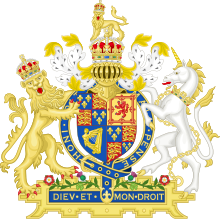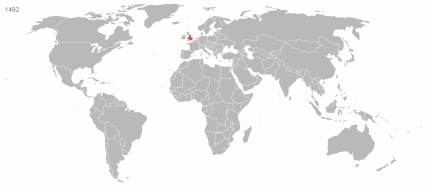Portal:British Empire
The British Empire Portal
TheBritish Empirecomprised thedominions,colonies,protectorates,mandates,and otherterritoriesruled or administered by theUnited Kingdomand its predecessor states. It began with theoverseas possessionsandtrading postsestablished byEnglandin the late 16th and early 17th centuries. At its height in the 19th and early 20th centuries, it was thelargest empire in historyand, for a century, was the foremost global power. By 1913, the British Empire held sway over 412 million people,23 percent of the world population at the time, and by 1920, it covered 35.5 million km2(13.7 million sq mi),24 per cent of the Earth's total land area. As a result,its constitutional,legal,linguistic,andculturallegacy is widespread. At the peak of its power, it was described as "the empire on which the sun never sets",as the sun was always shining on at least one of its territories.
During theAge of Discoveryin the 15th and 16th centuries,PortugalandSpainpioneered European exploration of the globe, and in the process established large overseas empires. Envious of the great wealth these empires generated, England,France,and theNetherlandsbegan to establish colonies and trade networks of their own in theAmericasandAsia.A series of wars in the 17th and 18th centuries with the Netherlands and France left England (Britain,following the1707 Act of Unionwith Scotland) the dominantcolonial powerinNorth America.Britain became a major power in theIndian subcontinentafter theEast India Company'sconquestofMughal Bengalat theBattle of Plasseyin 1757. TheAmerican War of Independenceresulted in Britain losing some of its oldest and most populous colonies in North America by 1783. While retaining control ofBritish North America(nowCanada) and territories in and near theCaribbeanin theBritish West Indies,British colonial expansion turned towards Asia,Africa,and thePacific.After the defeat of France in theNapoleonic Wars(1803–1815), Britain emerged as the principalnavaland imperial power of the 19th century and expanded its imperial holdings. It pursued trade concessions in China and Japan, and territory inSoutheast Asia.The "Great Game"and"Scramble for Africa"also ensued. The period of relative peace (1815–1914) during which the British Empire became the globalhegemonwas later described asPax Britannica(Latin for "British Peace" ). Alongside the formal control that Britain exerted over its colonies, its dominance of much of world trade, and of its oceans, meant that it effectivelycontrolled the economies of, and readily enforced its interests in, many regions,such as Asia andLatin America.It also came to dominate theMiddle East.Increasing degrees of autonomy were granted to its whitesettler colonies,some of which were formally reclassified asDominionsby the 1920s. By the start of the 20th century,Germanyand theUnited Stateshad begun to challenge Britain's economic lead. Military, economic and colonial tensions between Britain and Germany were major causes of theFirst World War,during which Britain relied heavily on its empire. The conflict placed enormous strain on its military, financial, and manpower resources. Although the empire achieved its largest territorial extent immediately after the First World War, Britain was no longer the world's preeminent industrial or military power. In theSecond World War,Britain's colonies inEast AsiaandSoutheast Asiawere occupied by theEmpire of Japan.Despite the final victory of Britain andits allies,the damage to British prestige and the British economy helped accelerate the decline of the empire.India,Britain's most valuable and populous possession, achievedindependencein 1947 as part of a largerdecolonisationmovement, in which Britain granted independence to most territories of the empire. TheSuez Crisisof 1956 confirmed Britain's decline as a global power, and thehandover of Hong Kong to Chinaon 1 July 1997 symbolised for many the end of the British Empire, though fourteenoverseas territoriesthat are remnants of the empire remain underBritish sovereignty.After independence, many former British colonies, along with most of the dominions, joined theCommonwealth of Nations,a free association of independent states. Fifteen of these, including the United Kingdom,retain the same person as monarch,currently KingCharles III.(Full article...)Selected article- ACrown colonyorroyal colonywas acolonygoverned byEngland,and thenGreat Britainor theUnited Kingdomwithin the English and laterBritish Empire.There was usually agovernorto represent the Crown, appointed by theBritish monarchon the advice of theUK Government,with or without the assistance of a local council. In some cases, this council was split into two: an executive council and alegislative council,and the executive council was similar to thePrivy Councilthat advises the monarch. Members of executive councils were appointed by the governors, and British citizens resident in Crown colonies either had no representation in local government, or limited representation in alower house.In several Crown colonies, this limited representation grew over time. As theHouse of Commonsof theBritish Parliamenthas never included seats for any of the colonies, there was no direct representation in the sovereign government for British subjects or citizens residing in Crown colonies. The administration of Crown colonies changed over time and in the 1800s some became, with a loosening of the power of royal governors,self-governing colonies,within which thesovereign state(the UK Government) delegated legislation for most local internal matters of governance to elected assemblies, with consent of the governor. Elected lower houses had their beginnings in theHouse of Burgessesof theColony of Virginiain 1619 and theHouse of Assemblyof theParliament of Bermudain 1620. While initially limited in government even with an elected lower house, over the centuries in some Crown colonies, more independent authority was given. (Full article...)Selected image Atopographic mapof theFalkland Islands,anarchipelagoin the SouthAtlantic Ocean,whichErnesto Sabatocalled: "the last trace of colonialism." Did you know
Related portalsCommonwealth Realm Other former British territories Selected biography-Victoria(Alexandrina Victoria; 24 May 1819 – 22 January 1901) wasQueen of the United Kingdom of Great Britain and Irelandfrom 20 June 1837 untilher deathin 1901. Her reign of 63 years and 216 days—which waslonger than those of any of her predecessors—constituted theVictorian era.It was a period of industrial, political, scientific, and military change within theUnited Kingdom,and was marked by a great expansion of theBritish Empire.In 1876, theBritish Parliamentvoted to grant her the additional title ofEmpress of India. Victoria was the daughter ofPrince Edward, Duke of Kent and Strathearn(the fourth son ofKing George III), andPrincess Victoria of Saxe-Coburg-Saalfeld.After the deaths of her father and grandfather in 1820, she wasraised under close supervisionby her mother and hercomptroller,John Conroy.She inherited the throne aged 18 after her father's three elder brothers died without surviving legitimate issue. Victoria, aconstitutional monarch,attempted privately to influence government policy and ministerial appointments; publicly, she became a national icon who was identified with strict standards ofpersonal morality.(Full article...)Evolution of the British EmpireSubcategoriesWikiProjectsBritish Empire and Commonwealth of NationsLegend
Current territory·Former territory
Latin Americaand theCaribbean
Things to doBritish overseas territoriesAssociated WikimediaThe followingWikimedia Foundationsister projects provide more on this subject:
| |||||||||||||||||||||||||||||||||||||||||















